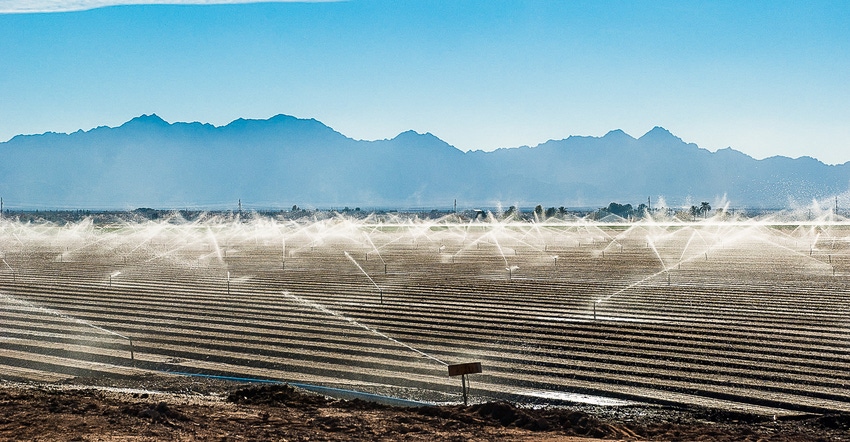
The Southwest could experience another water shortage from the Colorado River as drought conditions continue.
That message from Dr. Paul Brown, biometeorology specialist with the University Arizona Department of Soil, Water and Environmental Science, includes about half the normal spring inflows into Lake Powell, on the Arizona-Utah border.
Brown’s message at the Southwest Agricultural Summit blames a warm, dry winter across much of the Desert Southwest and a below-average snowpack throughout much of the West for his outlook of possible water cutbacks as drought continues.
Except for parts of Wyoming, it’s been “exceedingly dry and warm” throughout the Colorado River’s seven basin states, he said.
In Arizona, with temperatures an average of 4 degrees above normal for the Salt, Verde, Gila and Colorado drainages, more evaporation is occurring even as less snow and rain have fallen, leaving soil conditions very dry, he warned.
“There’s been almost no snowpack in Arizona,” he said. “California isn’t good either.”
After a wet winter last year, California is again experiencing a warm, dry winter and a renewed prospect of drought. Recent winter storm systems in both states have improved conditions, Brown said, but not enough so far to approach normal precipitation levels. Current projections put spring inflow at 51 percent of normal into Lake Powell.
“We’ve had one good flow in the last several years,” Brown said. “We’re not projecting an historic low flow this year, but the projected flow is still very low. We’re right on the cusp of declaring a shortage.”
No shortage will be declared for this year and probably not in 2019, he said. “But 2020 is looking less optimistic. The bottom line – it doesn’t look good. All decisions about conservation are getting pretty important,” Brown continued.
Conservation Recommendations
Conservation, such as removing lawns, is one strategy in two major metropolitan areas – central Arizona and the area in California serviced by the Metropolitan Water District of Southern California. But MWD and the Central Arizona Groundwater Replenishment District are both also on constant search for new water supplies to meet their obligations.
MWD was established by the California Legislature in 1928 to be the regional wholesale water supplier for much of Southern California. Today, it is the largest supplier of treated water in the U.S., servicing 19 million people across 5,200 square miles and six counties, said Shanti Rosset, program manager for Colorado River Resources for MWD. Two major water sources are the Sierra Nevada snowpack and the Colorado River.
However, as of mid-February, snowpack in the Sierra Nevada, source of one-third of California’s water, was at 21 percent of normal, according to the State Department of Water Resources. Meanwhile, there is increasing pressure on the drought-stricken Colorado River.
MWD responded on several fronts. It participated in the Quantification Settlement of 2003 that established a plan for California to live within its allocation of 4.4 million acre-feet of Colorado River water, and divided available water resources between the environmentally fragile Imperial Valley and the more heavily populated areas of Southern California. The agency also has invested heavily in increasing its water storage capacity.
In addition, MWD entered a 35-year agreement in 2004 with the Palo Verde Irrigation District that pays landowners to fallow portions of their land each year, freeing up water for the urban water district. An additional agreement between MWD and Bard Water District to fallow 2,000 acres will free up additional water while paying farmers not to grow crops.
Similar agreements are being sought by Central Arizona Groundwater Replenishment District, a separately funded division of the Central Arizona Project charged by statute with finding replacement water for groundwater pumped by its members. CAGRD has been satisfying its replenishment obligation primarily through recharge of excess CAP water. But future availability of that source is uncertain due in part to potential shortages on the Colorado River.
Therefore, said CAGRD Manager Perri Benemelis, “our strategy is to acquire a variety of different water supplies that will have different reliabilities under a shortage.”
Fallowing Projects Tested
In 2013, CAGRD entered an agreement with the Yuma Mesa Irrigation and Drainage District for a pilot fallowing program to test the process and quantify water savings, Benemelis said. That project ran from 2014 through 2016 with about 1,500 acres fallowed each year. Over the three years, a little over 21,000 acre-feet of water was saved, water that was retained in Lake Mead to help maintain the reservoir’s level.
“It was a small program, only 10 percent of the land,” Benemelis said. But it provided the methodology for future fallowing projects.
CAGRD currently is pursuing an agreement with Mohave Valley Irrigation and Drainage District that would involve seven farms. CAGRD intends to purchase 2,200 acres and lease other land to be fallowed on a rotational basis. “We would like it to be a long-term program,” she said.
Another agreement – this one between CAGRD and the town of Quartzsite, Ariz. – will lease the town’s unused allocation of Colorado River water (about 1,070 acre feet) because it lacks infrastructure to take delivery. That water has been going into the CAP delivery system as an unused allocation. Quartzsite could use the money to improve its well water system.
About the Author(s)
You May Also Like




